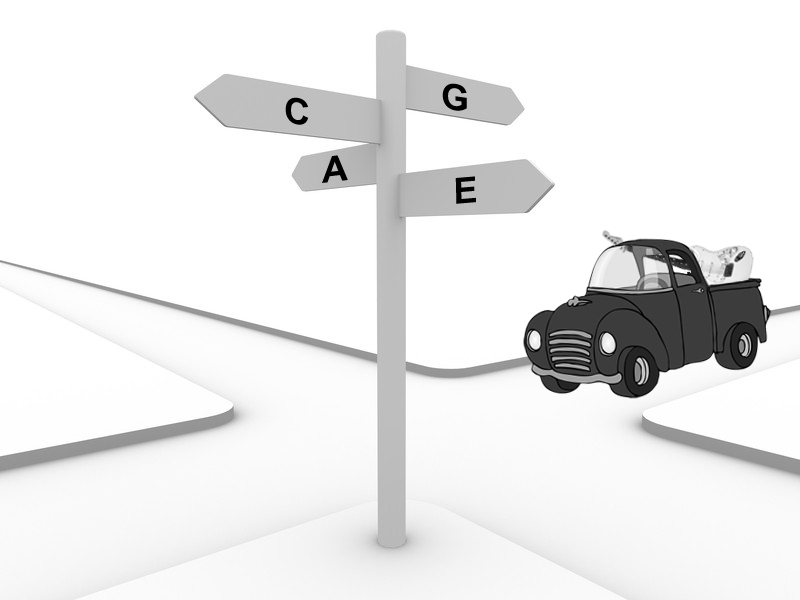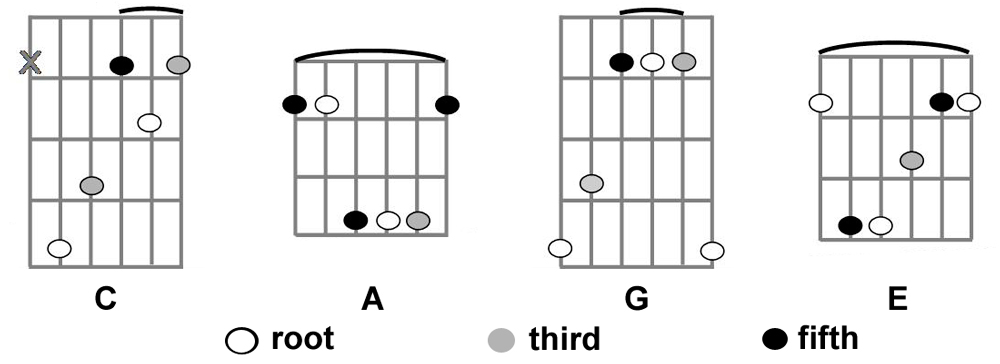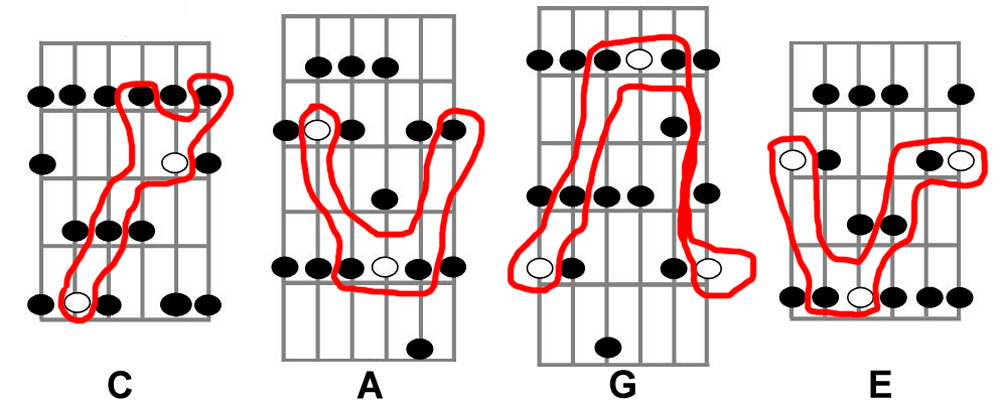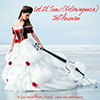At the Intersection of Major Arpeggios, Scales, and Triads: The CAGED System

If you're a seasoned guitarist you've probably heard of the CAGED system that links scales and chords by the five most common chord shapes: C, A, G, E, and D. It's a clever way to memorize the scales associated with the shape of the chords. There are lots of other ways to learn chords and scales, so it's best not to think that the CAGED system is the only way. (I don't personally use the CAGED system for scales very much but I think it has merit, especially when you're first trying to learn chord/scale relationships.) In this article I will introduce the CAGED system, and expand it to include arpeggios. My version might be better called the CAGE system, because it doesn't bother with learning the chord D, its corresponding chord shape, and the scale associated with it. I leave out the D chord because it isn't as useful in my opinion - plus I must confess that the one-page sheet I created that unites chords, scales, arpeggios, and music theory (found below) didn't have room for the D chord! (Of course I'm not advocating that you don't learn the open position D chord, because it's found in lots of songs. I'm just eliminating it from the CAGED system because the scale that corresponds to the open position D chord isn't as useful, in my opnion. If you don't know the D chord you can find it here on this website.)
Chords
The CAGE system, like the similar CAGED system, starts with four of the most common open position chords: C, A, G, and E. Almost all guitar players learn these chords first. They are pictured below. The red squares are roots and the dotted black squares are fifths. (If you're new to the concept of roots and fifths, you'll read a description of them below.

These are all major triads, which are constructed by starting with a note (the root, or letter name of the chords), adding a note four half-steps higher (the third), then adding one more note three half steps higher than the second note (the fifth). (You might want to look at my web article on triads found here.) Let's modify these open position chords so that they work as moveable barre chords. Notice the similarity of these barre chords to the open position counterparts shown above. The A-type and E-type barre chords (so called because they're derived from the A and E open position chords), are by far the most used types. The C-type is useful but not-as-often used, while the G-type is rarely used because it involves a somewhat awkward stretch. The diagram below shows which strings can be strummed, and where the barre is used - across six or three strings. (The barred strings are indicated by the curved line above each chord.) Also, each member of the chord is indicated by three different colored dots. (If you want to learn how triads work and what members are, check out this page on my website.)

Arpeggios
We've just covered the chords in CAGE: C, A, G, E. Next up on our list of the uses of the CAGE system are arpeggios. Arpeggios use the notes in a chord but they're played in succession, not at the same time. These will look much like the chords shown above, with a few added notes because we generally play all available notes of the chord. This means that we may find two notes on a single string (sometimes more for other kinds of arpeggios). The chords C, A, G, and E are called triads because they include only three different letter names. For example, the members of a C chord are C (root), E (third), and G (fifth). A C chord arpeggio is usually played using all of the available members, one-by-one in a row, sometimes spanning less than an octave (seven or fewer consecutive letter names), equal to an octave(spanning exactly eight consecutive letter names), and more than an octave (a span of nine or more consecutive letter names).
Shown below are the arpeggios that correspond to the C, A, G, and E chords. Keep in mind that there are other fingerings for these arpeggios, some of which are easier than the CAGE ones. Notice that I have labeled any roots, thirds, and fifths using the same symbols as the chords above. If you look closely, you will see the C, A, G, and E chords contained within these arpeggio patterns. That's one of the benefits of learning the CAGE system - the similarity of the arpeggios to the chords - though it's important to note that there are other forms for each of these arpeggios, some of which are easier.

Scales
Last on our list for the CAGE system are scales. Scales are a pattern, usually but not always constructed using consecutive letter names, that follow a specific sequence of intervals. For example, a major scale is always built of consecutive letter names using the pattern 2212221, where the numbers represent the distance between the notes in half-steps. In other words, the distance between the first and second notes is two half-steps, the distance between the second and third notes is two half-steps, the distance between the third and fourth notes is one half-step, etc. Half-steps on guitars are found on two frets right next to each other. (On the piano, half-steps are the shortest distance between keys, in other words, two keys right next to each other such as B and C or C# and D.) Since the chords and arpeggios above are major, the matching scales are also major. (If you want to learn more about chords and major scales please check out this page on this website.) The patterns below are the matching scales for the C, A, G, and E chords and their respective arpeggios. It's a little more difficult to see the C, A, G, and E chord patterns contained within these scale forms, so I have circled the corresponding chord in red. Here the root (tonic) is white while the other notes of the scale are black. Like the chords and arpeggios above, these forms are moveable up and down the neck: whatever pitch the white fretted notes are on, determines the key of the scale. If you move the C scale up the neck (higher in pitch) so that the white circles end up on D's (the white circles in each scale are always the same letter name), the scale becomes a D major scale. This is true for the chords and arpeggios shown directly above.

All of the Above Information on a Single Sheet
Found below is a single graphic that represents chords, scales, and arpeggios in the CAGE system, plus a music theory box on the bottom which helps you understand how major chords are constructed, how they are inverted, and the respective chord symbols. (You can download a PDF version below.)
I've packed a lot of information into this web article and onto the sheet below, so you may have to set aside some study time to understand it all. There are many things in this web article that I would have liked to explain in more detail, but to keep this article short, I have chosen to explain them in more general terms. If you are really struggling with this material, you may want to look at the other pages on this website listed above. NOTE: When I created this sheet a few years ago, I did not put the chords, scales, and arpeggios in CAGE order. Instead it's EACG from left to right. By the way, major scales can also be called Ionian scales: oddly enough, two different names for the same thing.
Jeff Anvinson, owner/operator of JLA Music
Click here to get a PDF version of this music theory sheet. Please don't distribute this PDF by photocopying or posting it on the internet. You may print out one copy for your own use. If you know someone who wants a copy, simply refer them to this website. Please help me protect my intellectual property by respecting my rights.

Website and most graphics are created inhouse by Jeff Anvinson, Owner/Operator of JLA Music
Some graphics are purchased from Can Stock Photo, used by permission, and are Copyright
© Can Stock Photo
JLA Music takes care not to infringe on anyone's rights. Please contact us at jla@jlamusic.com if you have questions.
Copyright 2025 © Jeff Anvinson, JLA Music


